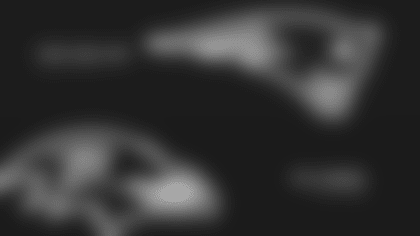The Patriots went into the draft with three major needs that the top brass weren't shy about sharing.
Early in his regime, head coach Jerod Mayo made it crystal clear that New England had to address three holes on the offensive side of the ball this offseason: quarterback, wide receiver, and offensive tackle. The Patriots invested significant draft capital by selecting UNC quarterback Drake Maye third overall and double-dipping at wide receiver.
At offensive tackle, the Pats re-signed standout offensive lineman Mike Onwenu with the intention of playing Onwenu at right tackle. Despite being built like a guard, Onwenu has held up well in his 26 career starts, including 11 last season, at right tackle. However, there's still uncertainty about who will start at the other tackle spot.
During his pre-draft press conference, de facto general manager Eliot Wolf said that if the season started today, veteran Chuks Okorafor would be the starting left tackle. Okorafor hasn't regularly played the position in his six NFL seasons but was a starting left tackle at Western Michigan. Still, tackle remained a top need heading into the draft.
With the 68th overall pick in the third round, the Patriots selected Penn State tackle Caedan Wallace. Wallace, like Okorafor, is a right tackle by trade with 40 career starts on the right side for the Nittany Lions. New England selected Wallace at the backend of the day-two tackle run. Due to his inexperience on the left side, Wallace, and how the team addressed left tackle, is the most common second guess in the draft for the Patriots.
A cluster of tackles went on day two, starting with Houston left tackle Patrick Paul at 55th overall to the Dolphins. Paul went to Miami midway through the second round, which started a run at the position. Blake Fisher (59), Roger Rosengarten (62), Kingsley Suamataia (63), and TCU's Brandon Coleman (67) flew off the board, with Coleman going the pick before the Patriots took Wallace at No. 68 last Friday night.
Like Wallace, several of those players also project as right tackles or guards at the next level. However, Paul and Suamataia are pure left tackles, while Coleman made 34 career starts at left tackle for the Frogs. Did the Patriots fail to predict the run? Can Wallace successfully flip to the left side? Making an aggressive move up the board to leapfrog other tackle-needy teams would've been ideal. But maybe the Patriots couldn't find a trade partner. Perhaps they're trusting their scouting that Wallace is the best player. Doubting them after the fact is easy.
Still, the Patriots are trusting offensive line coach Scott Peters to get starting-caliber left tackle play out of two career right tackles, Okorafor and Wallace. In the short term, it's a gamble.
Let's dig into Wallace's film and discuss possible offensive line combinations for the Patriots:
Before we get into Wallace's film, it's important to contextualize his time at Penn State and his development as a day-two pick along the offensive line.
As Wolf told reporters after the pick was made, Wallace was a four-year starter at right tackle for Penn State partially because first-round pick Olu Fashanu was a stud on the other side. Fashanu started the last two seasons for the Lions at left tackle. Although it's probably not the only reason, Wallace was blocked from flipping sides despite having NFL-caliber talent.
In 2022, Wallace's disappointing season was cut short by five games due to an ankle injury. The 24-year-old was eligible to enter the NFL draft as a redshirt junior but was advised to return to school to improve his draft stock. If he had come out following the 2022 season, he would've likely been an undrafted free agent. Instead, he returned to Happy Valley for his redshirt senior season, where Wallace improved significantly.
Although he's an older prospect who is a late bloomer, Wallace has starting-caliber traits in his athleticism (8.23 out of 10 RAS), stout frame and good length (34-inch arms, 10 ¾-inch hands), and body control. He has good initial quickness out of his stance, a stout anchor to recover, and plays long with a solid two-hand punch in his pass sets. As a run blocker, Wallace creates lateral displacement on zone blocks and effectively climbs to the second level.
Overall, there's a lot to like about his movement skills and functional strength. However, despite his experience (40 starts), Wallace's technique remains a major work in progress. His physical tools suggest that he should be more consistent, but some legitimate concerns about his pass sets make you worry about him sticking at tackle in the NFL, let alone left tackle.
It's important to remember that Wallace was the 68th overall pick, not the sixth pick, for a reason. Wallace wouldn't have been on the board in the third round if he had these athletic traits with polished technique. We must keep that in perspective now and in the future when discussing Wallace as a potential option to start the year at tackle. That seems lofty.
Pass Sets
Starting with the positives, Wallace only allowed one sack and seven total pressures on 125 true pass sets or traditional drop-backs last season (no screens, play-action, quick-game, etc.).
Although the Patriots plan to limit exposure to traditional drop-backs, Wallace's volume and, of course, level of difficulty will increase significantly at the next level. Still, those are good numbers in the Big 10, where there's NFL-caliber edge rush talent throughout the conference.
The strengths of Wallace's game in pass protection are his balance/body control, patience, anchor, and maximizing his arm length to keep rushers at his fingertips. He hardly ever looks out of control with his technique and plays long to maintain good posture within fluid movements that aren't segmented or choppy, allowing him to mirror rushers on an island.
In these examples against future NFL edge rushers Jack Sawyer and J.T. Tuimoloau from Ohio State, you see that ability to stay balanced in his pass set and unlock his length to keep them at bay. In the third clip, Tuimoloau tries an inside spin on Wallace, and you can see the powerful redirect strides he has to shut down the move on an extended drop-back.
Here, Wallace shows his range to block the speed rush past the quarterback, uses an effective snatch-trap technique to shut down a bull rush, and quickly anchors against power. Like Ohio State, Michigan always has its fair share of NFL-caliber defensive talent.
Those reps will all translate nicely to the next level, but Wallace has problems in pass protection against high-end speed rushers who test his edge at the snap. Wallace is prone to being an early hip opener and will play too aggressively against explosive first-step rushers.

To explain what that means, let's compare Wallace to Fashanu in the early stages of their pass sets. In the image above, both Penn State tackles are on their second kick in their slide. As you can see, Fashanu's hips are squaring up the rusher. On the other side, Wallace has already swung his gate open with his hips pointed toward the sideline, creating a short corner.
This creates two potential problems. First, it compromises the width of the pocket. Tackles want to move laterally and kick out toward pass-rushers to make them travel the longest possible path to the quarterback. So, when Wallace opens his hips early, it shortens the corner. As you can see above, bendy speed rushers take full advantage.
Another issue it can cause is that well-schooled rushers will go to their inside counters when Wallace opens early and commits to his two-hand punch. In this clip, he opens early and gets overextended with his punch, so the edge rushers spins inside him for a quarterback pressure.
With a premium pick used on Wallace, everyone is probably wondering can it be fixed? My short answer is that anything can be fixed with effort on the players' part and proper coaching. How? That's outside my purview and a question we'll hopefully get to ask Scott Peters soon.
If Wallace doesn't fix his pass-set technique, we have serious concerns about his long-term future as an offensive tackle in the pros.
Run Blocking
Moving on to run blocking, Wallace is a bit further along with more correctable issues to unlock his power fully with improved pad level.
With above-average athleticism, Wallace has a good initial burst into engagements to create immediate displacement. He can win suddenness and great arm extension on angle blocks, while he's highly effective on combination blocks where he's asked to climb to the second level.
Here, you can see it all come together for Wallace on the combination block. He has good timing after bumping the first-level defender, shows great body control and light feet to square up his target at the second level, and steers the linebacker out of the rushing lane for a big play.
The one area where Wallace will need to improve as a run blocker is his pad level. Although he goes into the block with a good upward strike and proper leverage, his pads rise as the play continues. This limits his power at the point of attack, and Wallace gets stalemated more than he should on kick-out blocks, lateral reaches, and double-teams.
There's real upside for Wallace on zone run schemes that allow him to use his athleticism on lateral reaches, climbs to the second level, and as a lead blocker on screens.
Bottom Line
The Patriots seem to have the confidence in their coaching staff to convert Wallace into a left tackle, and who are we to doubt them? For now.
Head coach Jerod Mayo hired former Browns understudy Scott Peters as the team's offensive line coach. Peters learned under legendary O-Line coach Bill Callahan in Cleveland, and is known as a technique guru. The Pats new line coach has a solid resume to grow into the role.
Plus, offensive coordinator Alex Van Pelt will have a hand in protecting the offensive line. Van Pelt is expected to install an outside zone system, where they'll stretch the defense horizontally and set up misdirection. Van Pelt will likely dial up heavy play-action and moving pockets (bootlegs). Furthermore, the Browns were known for protections with extra blockers. Those play designs should limit the amount of exposure the offensive line has to one-on-one pass rushes from traditional drop-backs. In theory, it's an easier system for offensive linemen to execute.
If you don't want to take the Patriots top decision-maker's word for it, I consulted with O-Line guru Brandon Thorn on Wallace transitioning to left tackle. Brandon writes for Bleacher Report and Trench Warfare. He is my go-to for offensive line play:
"Wallace could feasibly play on the left given that athletic ability and movement skills in pass pro are some of his top strengths. Plus, he passes most size thresholds for the position. Given that he has been exclusively a right tackle in college clouds the projection a bit, but on the current depth chart I don't think there's much of a question that he at least has the most upside at left tackle," Thorn said, while acknowledging the Patriots current options are limited.
New England's current plan to flip veteran Chuks Okorafor and Wallace to left tackle is a dice roll. Okorafor hasn't played on the left side at a high volume since college (seven years ago), while Wallace played 99.8% of his snaps in college at right tackle — it's far from a sure thing. The current personnel suggests there will be a weaker link at left tackle in 2024. However, the best path forward is to allow the long-term pieces to solidify themselves at their natural spots, with an eye toward the 2025 draft to fill the left tackle need with an early draft choice.
To play out this scenario, the Patriots would live with Okorafor at left tackle this season. Then, they'd have entrenched starter David Andrews at center and keep Onwenu at right guard, his natural position. Wallace would develop at right tackle, his natural spot, while the trio of Cole Strange, Sidy Sow, and Layden Robinson compete at left guard.
Obviously, the Patriots don't need to commit to this right away. And it doesn't hurt to try Wallace at left tackle in camp. Maybe he can play it at a high level. It's worth a look. But it's easier to envision this being their best five eventually: LT Okorafor, LG Strange/Sow/Robinson, C Andrews, RG Ownenu, RT Wallace. The last puzzle piece would come in the 2025 draft, where they can drop a high pick at left tackle into an already ascending group: Will Campbell (LSU) or Kelvin Banks Jr. (Texas) YOU are a Patriot.
It's important to remember Rome wasn't built in a day. Mayo, de facto GM Eliot Wolf, and all of Patriots nation want to win. Trust me, we all do. But it's going to take patience and a long-term perspective, where 2025-2028 is this team's realistic contending window, assuming third-overall pick Drake Maye's development goes as planned.
The best thing for the 2024 Patriots is to see if they can expedite the process by flipping Wallace to left tackle. However, a more realistic outlook could be to get 4/5th's of the line figured out, so the left tackle next year completes an even prettier picture.
There's reason for optimism that Wallace can develop into a starter somewhere on the line, but his permanent home remains unknown.
DISCLAIMER: The views and thoughts expressed in this article are those of the writer and don't necessarily reflect those of the organization. Read Full Disclaimer













































